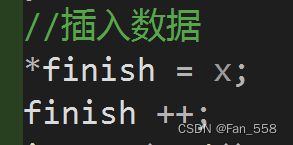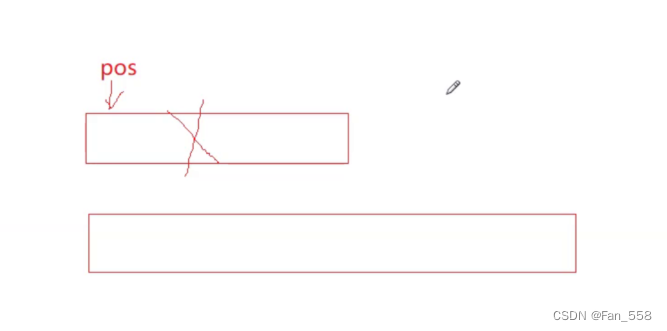前言
本文将会向您介绍如何模拟实现vector
引入
Vector是一种动态数组,也是C++标准库中的容器之一。它提供了一种存储和操作一系列元素的方式,类似于数组,但具有更多的功能和灵活性。
Vector可以存储不同类型的元素,并且可以根据需要动态调整大小。它使用连续的内存块来存储元素,使得元素的访问和遍历效率较高。与普通数组相比,Vector的大小可以动态增长或缩小,而不需要手动编写代码来重新分配内存。
Vector提供了一系列的成员函数和操作符,可以方便地进行元素的插入、删除、访问和修改等操作。它还支持迭代器,可以通过迭代器遍历Vector中的元素。
功能分解
构造
提供了一个默认的构造,和一个n个value的构造
//构造vector(){}//构造vector(int n, const T& value = T()){reserve(n);for (int i = 0; i < n; i++){push_back(value);}}
拷贝构造
解析:假设用v1拷贝v2,v是v1的别名,将v的内容尾插到v2中

//v2(v1)vector(const vector<T>& v){reserve(v.capacity());for (auto& e : v){push_back(e);}}
赋值重载
void swap(vector<T>& v){std::swap(start, v.start);std::swap(finish, v.finish);std::swap(end_of_storage, v.end_of_storage);}vector<T>& operator= (vector<T> v){swap(v);return *this;}
析构
~vector(){delete[] start;start = finish = end_of_storage = nullptr;}
迭代器
Vector源代码中使用了start、finish、endofstorage三个指针
start指针指向vector中的第一个元素的位置。
finish指针指向vector中最后一个元素的下一个位置。也就是说,finish指针指向vector中当前元素的末尾位置。tips:[start , finish)
endofstorage指针指向vector内部分配的内存空间的末尾位置。这个指针通常用于判断vector是否需要重新分配内存空间。
iterator begin(){return start;}iterator end(){return finish;}const_iterator begin() const{return start;}const_iterator end() const{return finish;}//获取大小size_t size() const{return finish - start;}//获取容量size_t capacity() const{return end_of_storage - start;}
尾插:当size与capacity相等时,就需要进行扩容。
以下一个步骤相当于扩容,当尾插需要扩容时,对capacity进行修改
而reserve只是完成扩容的剩下步骤(拷贝空间到新空间,释放旧空间,更新指针指向的位置)
reserve(capacity() == 0 ? 4 : capacity() * 2);
当capacity为0时,赋值4,当capcaity不为0时capacity*2作为参数给reserve
void push_back(const T& x){if (size() == capacity()){//扩容reserve(capacity() == 0 ? 4 : capacity() * 2);}//插入数据*finish = x;finish ++;//复用//insert(end(), x);}
Reserve
开空间:
场景一:当尾插size与capacity相等时,n接收应需要扩容的大小
开辟一个新空间
T* tmp = new T[n];
如果start不为空,就需要把原来空间里的内容拷贝到新空间里,然后在再释放旧空间
if (start)
{
}
void reserve(size_t n){size_t sz = size();//开空间if (n > capacity()) {T* tmp = new T[n];//如果start不为空就要拷贝就空间//memcpy(tmp, start, sizeof(T) * sz);if (start){for (int i = 0; i < sz; i++){tmp[i] = start[i];}delete[] start;}//更新start = tmp;finish = start + sz;end_of_storage = start + n;}}
注意:
在更新指针指向的空间时,这里需要提前保存size的大小
不能按如下写法
finish = start + size();
当还没有插入数据时,start应与finish指向的位置相同位于起始位置0处,size( )应为0.但是size()不为0,size = finish - start 旧空间的finish - 新空间的start(tmp)

Resize
改变大小: n的可能有两种情况,第一是n <= size,直接改变finish指向的位置即可
第二时n > size,需要进行扩容,并且插入Value值
const T& value = T()
//改变大小void resize(size_t n, const T& value = T()){if (n <= size()){finish = start + n;}else{reserve(n);while(size_t(finish - start) < n){*finish = value;++finish;}}}
Insert
在任意位置pos处插入:
判断有效位置、判断扩容、挪动数据、插入数据
以上步骤的逻辑较为简单不再讲解
注意:
必须要记录pos的相对位置,再对pos进行更新
否则:pos指向要插入的位置,如果扩容后,会将旧空间释放掉,其中包括pos指向的位置,这样一来pos就变成野指针,解引用插入数据的时候就会有问题
size_t len = pos - start;reserve(capacity() == 0 ? 4 : capacity() * 2);pos = start + len;

iterator insert(iterator pos, const T& x){//判断有效位置assert(pos >= start);assert(pos <= finish);//判断扩容if (size() == capacity()){//pos失效size_t len = pos - start;reserve(capacity() == 0 ? 4 : capacity() * 2);pos = start + len;}//挪动数据T* end = finish - 1;while (end >= pos){*(end + 1) = *end;end--;}*pos = x;finish++;return start;}
另外当我们进行以下测试的时候会出现以下错误

原因是:
当我们向一个vector中插入元素时,pos是it的拷贝,虽然我们在insert中对pos进行修正,但是pos的修改并不会影响到it迭代器,这种情况下,原有的迭代器指向的内存地址已经不再有效,因此不能再使用。
void test3()
{vector<int> v;v.push_back(1);v.push_back(2);v.push_back(3);v.push_back(4);vector<int>::iterator it = v.begin() + 2;v.insert(it, 30);for (auto e : v){cout << e << " ";}cout << endl;v.insert(it, 20);for (auto e : v){cout << e << " ";}
}
Erase
删除:判断有效位置、覆盖数据,最后 - -finish
以上步骤较为简单,就不在这里进行讲解
iterator erase(iterator pos){//判断有效位置assert(pos >= start);assert(pos < finish);iterator end = pos + 1;while (end < finish){*(end - 1) = *end; end++;}finish--;return start;}
注意:
当我们测试以下数据并且想erase掉偶数
我们像以下写法使用迭代器还会导致像insert时迭代器失效一样的问题吗
答案是:会的
while (it != v3.end()){if (*it % 2 == 0){v3.erase(it);}it++;}
测试数据:1 2 2 3 4 5

我们可以观察到,此时并没有erase掉偶数
原因是 it 指向第一个2的位置,当我们erase移动覆盖第一个2时,此时 第二个2就跑到了it指向的位置,然后再++it,本来应对第二个2进行判断的时候,却直接跳过了

测试数据:1,2,3,4,5,6

VS有个特点:erase后不让再使用迭代器,进行了强制检查
当我们erase最后一个偶数时,finish–,然后it++,这会导致it != v3.end()直接失效

C++库也给出了解决方案
返回被删除数据的下一个位置,我们只需要接收这个位置即可

void test_vector3()
{vector<int> v3;v3.push_back(1);v3.push_back(2);v3.push_back(2);v3.push_back(3);v3.push_back(4);v3.push_back(5);v3.push_back(6);for (auto e : v3){cout << e << " ";}cout << endl;Fan::vector<int>::iterator it = v3.begin();while (it != v3.end()){if (*it % 2 == 0){it = v3.erase(it);}else{it++;}}for (auto e : v3){cout << e << " ";}
}
测试用例
//void test_vector1()
//{
// vector<int> v1;
// v1.push_back(1);
// v1.push_back(2);
// v1.push_back(3);
// v1.push_back(4);
// v1.push_back(5);
// v1.insert(v1.begin() + 3, 1);
// v1.insert(v1.begin(), 0);
// v1.insert(v1.end(), 1);
// Fan::vector<int>::iterator it = v1.begin();
// while (it != v1.end())
// {
// cout <<" "<< * it;
// ++it;
// }
//}//void test_vector2()
//{
// vector<int> v2;
// v2.push_back(1);
// v2.push_back(2);
// v2.push_back(3);
// v2.push_back(4);
// v2.push_back(5);
// v2.push_back(6);
// v2.push_back(7);
// for (auto e : v2)
// {
// cout << e << " ";
// }
// cout << endl;
// v2.erase(v2.begin() + 1);
// v2.erase(v2.begin() + 1);
// for (auto e : v2)
// {
// cout << e << " ";
// }
//}
//void test_vector3()
//{
// vector<int> v3;
// v3.push_back(1);
// v3.push_back(2);
// v3.push_back(2);
// v3.push_back(3);
// v3.push_back(4);
// v3.push_back(5);
// v3.push_back(6);
// for (auto e : v3)
// {
// cout << e << " ";
// }
// cout << endl;
// Fan::vector<int>::iterator it = v3.begin();
// while (it != v3.end())
// {
// if (*it % 2 == 0)
// {
// it = v3.erase(it);
// }
// else
// {
// it++;
// }
// }
// for (auto e : v3)
// {
// cout << e << " ";
// }
//}
//void test_vector4()
//{
// vector<int> v4;
// v4.push_back(1);
// v4.push_back(2);
// v4.push_back(2);
// v4.push_back(3);
// v4.push_back(4);
// v4.push_back(5);
// v4.push_back(6);
// for (auto e : v4)
// {
// cout << e << " ";
// }
// v4.pop_back();
// cout << endl;
// for (auto e : v4)
// {
// cout << e << " ";
// }
// cout << endl;
// cout << v4[1];
//}
//void test_vector5()
//{
// vector<int> v5;
// v5.push_back(1);
// v5.push_back(2);
// v5.push_back(2);
// v5.push_back(3);
// v5.push_back(4);
// vector<int> v6;
// v6 = v5;
// for (auto e : v6)
// {
// cout << e << " ";
// }
//}
//void test_vector6()
//{
// vector<string> v6;
// v6.push_back("1111111111111111111");
// v6.push_back("1111111111111111111");
// v6.push_back("1111111111111111111");
// v6.push_back("1111111111111111111");
// v6.push_back("1111111111111111111");
// v6.push_back("1111111111111111111");
// v6.push_back("1111111111111111111");
// v6.push_back("1111111111111111111");
// v6.push_back("1111111111111111111");
// v6.push_back("1111111111111111111");
// for (auto e : v6)
// {
// cout << e << " ";
// }
//}
//void test_vector7()
//{
// vector<int*> v1;
// v1.resize(10);
// vector<string> v2;
// v2.resize(10, "xxx");
// for (auto e : v1)
// {
// cout << e << " ";
// }
// cout << endl;
// for (auto e : v2)
// {
// cout << e << " ";
// }
//}
//void test_vector8()
//{
// vector<string> v1;
// v1.resize(10, "xxx");
// vector<string> v2(v1);
// for (auto e : v2)
// {
// cout << e << " ";
// }
// cout << endl;
// vector<string> v3(v2.begin(), v2.end());
// for (auto e : v3)
// {
// cout << e << " ";
// }
//}
int main()
{//test_vector1();//test_vector2();//test_vector3();//test_vector4();//test_vector5();//test_vector6();//test_vector7();//test_vector8();return 0;
}小结
关于本文Vector代码已经上传到gitee了,如果本文存在遗漏或错误的的地方,还请您能够指出。

)


)




--- 前端开发语言之HTML、CSS、JavaScript)





 更新日志)



